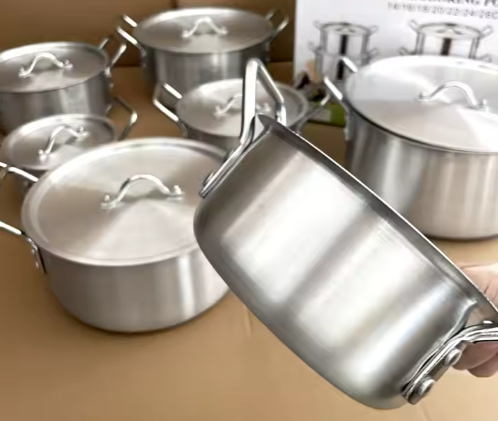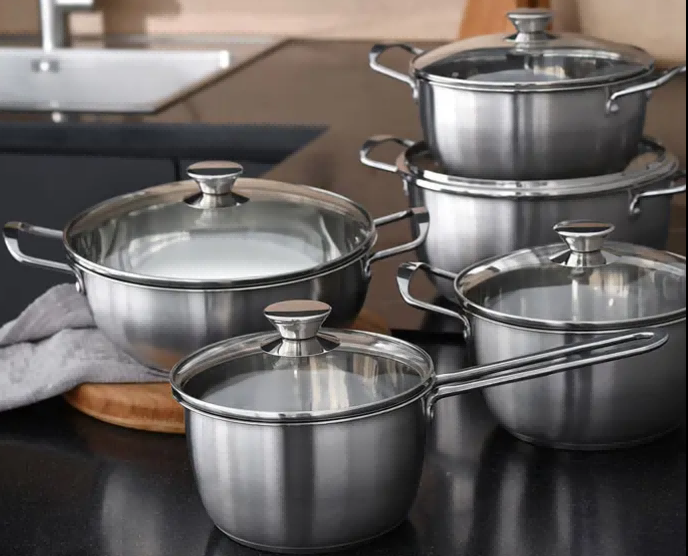皆さんこんにちは、今日は2つの一般的な台所用品についてお話したいと思います。 ステンレス調理器具.料理は生活に欠かせないものであり、適切な調理器具を選ぶことで、料理の幅が大きく広がる。アルミ製の調理器具とステンレス製の調理器具には、それぞれ調理における長所と短所があり、その特性の違いによってキッチンでの役割も異なります。
プロフェッショナルとして 卸売調理器具メーカーそこで、それぞれの特徴を詳しく紹介する。
アルミニウム調理器具:効率的な熱伝導
アルミニウム製の調理器具は、その優れた熱伝導性から、業務用厨房でも家庭用厨房でも非常に人気がある。
アルミニウム調理器具の利点
熱伝導率: アルミ製の調理器具は、熱を素早く均一に伝えることができ、熱伝導率が一般的な金属の数倍あるため、調理工程が効率的になります。従業員や労働者にとっては、朝食の準備を手早く済ませるためのファーストフード調理にアルミ鍋を使うことは、特に時間の節約になる!
軽量だ: アルミ製の調理器具はとても軽く、持ち運びが簡単で、アウトドアクッキングや毎日のキッチン作業に適している。
経済的だ: 他の素材に比べ、アルミ製調理器具は、豊富なアルミ資源と比較的低い加工費により、より手頃な価格となっている。
アルミ製調理器具の欠点
しかし、デメリットもある:
耐摩耗性はない: アルミニウムは柔らかく傷がつきやすいため、外観や耐用年数に影響を与える。
酸性食品は苦手: アルミニウムは酸性環境下で化学反応を起こしやすく、アルミニウムの溶解を引き起こし、人体に一定の影響を与える。
高温には強くない: アルミニウムは熱伝導率が良いが、融点は比較的低い。純アルミニウム製の調理器具は高温で変形しやすく、高温のバーベキューや長時間の高温加熱には適さない。そのため、多くのアルミ鍋には焦げ付き防止加工やアルマイト加工が施され、耐久性を高めている。

ステンレス調理器具:耐久性と安全性
ステンレス製の調理器具は、キッチンにおける「耐久性」の代名詞であり、非常に高度な調理器具の選択肢でもある。
ステンレス調理器具の利点
安全だ: ステンレス製の調理器具は酸性やアルカリ性の食品と反応せず、高温でも有害物質を放出しない。非常に安全な選択である。
掃除がしやすい: ステンレススチールは表面が滑らかで、食べ物のカスを吸収しにくい。普通の洗剤と柔らかい布で簡単に洗うことができます。
アルミ製調理器具の欠点
熱伝導率が悪い: 単層ステンレスはアルミほど熱伝導率が高くないため、加熱時に理想的な調理温度に達するまで時間がかかることがあります。しかし現在では、アルミの熱伝導性とステンレスの耐久性を併せ持つ3層構造の複合底ステンレス鍋が数多く販売されており、調理に最適な選択肢となっている!
価格が高い: 高品質のステンレス製調理器具は、熱伝導性と耐久性を向上させるために、通常、複合材料の複数の層で設計されています。このようなプロセスと材料のコストは、ステンレス鋼調理器具の価格は一般的にいくつかの伝統的な調理器具よりも高く、品質を追求するユーザーに適しています。

アルミ鍋対ステンレス鍋
| アスペクト | アルミ調理器具 | ステンレス調理器具 |
| 熱伝導率 | 熱伝導性に優れ、素早く均一に加熱されるため、スピード調理に最適。 | 単層設計では熱伝導性が悪いが、多層設計では性能が向上する。 |
| 重量 | 軽量で扱いやすく、小さなキッチンや屋外での使用に最適。 | 重く、安定性に優れ、キッチンの長期使用に適している。 |
| 耐久性 | 素材が柔らかく、傷や変形が生じやすい。 | 耐久性、耐食性に優れ、傷がつきにくい。 |
| 価格 | 費用対効果が高く、より手頃な価格。 | 初期費用は高いが寿命が長いため、長期的には経済的である。 |
| 健康と安全 | 酸性またはアルカリ性の食品と反応する可能性があり、潜在的なリスクがある。 | 食品と反応しないため、高い安全性を確保できる。 |
| 掃除のしやすさ | ノンスティック・コーティングはお手入れが簡単ですが、時間の経過とともに磨耗することがあります。 | 滑らかな表面はこびりつきにくく、お手入れの手間を省きます。 |
| 外観 | さまざまな色があり、アルマイト仕上げも多い。 | クラシックでエレガントな外観の、なめらかなメタリック仕上げ。 |
| 耐熱性 | 純アルミニウムは高温で変形する可能性があり、ノンスティックコーティングの耐性には限界がある。 | 耐熱性に優れ、高温下でも形状を維持する。 |
| ベスト・ユース・シナリオ | 手早く調理でき、予算も抑えられる。 | 品質、安全性、長寿命を最優先する人に最適。 |
二者択一
コストパフォーマンスを重視し、手早く調理する必要があることが多いのであれば、アルミ製調理器具は良い選択だろう。
耐久性や健康・安全性を追求するなら、ステンレス製の調理器具が適している。特に、底面が複合構造になっているため、火の通りも早く、ムラなく調理できる。
概要
アルミ製の調理器具とステンレス製の調理器具にはそれぞれ特徴がある。最も重要なことは、実際のニーズに合わせて調理器具を選ぶことです。
予算に余裕があれば、アルミ製フライパン+ステンレス製スープポットといった組み合わせも考えられる。アルミの熱伝導の速さと均一性を享受できるだけでなく、ステンレスの耐久性と安全性も考慮できます。
この記事を共有することで、皆さんがアルミ製とステンレス製の調理器具の特徴をより深く理解し、最適な調理器具を選ぶ一助となれば幸いである。
